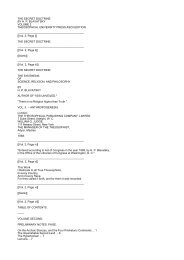You also want an ePaper? Increase the reach of your titles
YUMPU automatically turns print PDFs into web optimized ePapers that Google loves.
Plate III.<br />
Khemennu, just weigher"; and in British Museum papyrus No. 9900, "Thoth, lord <strong>of</strong> <strong>the</strong> scales."<br />
2. Birch, in Bunsen's Egypt's Place, vol. v., p. 259. In <strong>the</strong> papyrus <strong>of</strong> Anhai (British Museum, No. 10,472) <strong>the</strong>re is a<br />
meskhen on each side <strong>of</strong> <strong>the</strong> upright <strong>of</strong> <strong>the</strong> balance: one is called Shai and <strong>the</strong> o<strong>the</strong>r Renen.<br />
3. Four goddesses bore <strong>the</strong> name <strong>of</strong> Meskhen, and <strong>the</strong>y were supposed to assist <strong>the</strong> resurrection <strong>of</strong> Osiris; <strong>the</strong>y were<br />
associated with Tefnut, Nut, Isis, and Nephthys (see Lepsius, Denkmäler, iv., Bl. 59a; and Mariette, Dendérah, iv., pl. 74<br />
a). Each wore upon her head <strong>the</strong> object ###, which is said by some to represent <strong>the</strong> blossoms <strong>of</strong> palm trees (Lanzone,<br />
Dizionario, p. 329). Examples <strong>of</strong> this as an amulet, in hard stone, in <strong>the</strong> British Museum, are Nos. 8158, 8159, 8161,<br />
20,618, and, in porcelain, No. 15,963.]<br />
{p. 257}<br />
presiding over <strong>the</strong> birth-chamber, and Renenet[1] probably superintending <strong>the</strong> rearing <strong>of</strong> children.<br />
Behind <strong>the</strong> meskhen is <strong>the</strong> soul <strong>of</strong> Ani in <strong>the</strong> form <strong>of</strong> a human-headed bird standing on a pylon. On <strong>the</strong><br />
right <strong>of</strong> <strong>the</strong> balance, behind Anubis, stands Thoth,[2] <strong>the</strong> scribe <strong>of</strong> <strong>the</strong> gods, with his reed-pen and<br />
palette[3] containing black and red ink, with which to record <strong>the</strong> result <strong>of</strong> <strong>the</strong> trial. Behind Thoth stands<br />
<strong>the</strong> female monster Amam[4], <strong>the</strong> "Devourer," or Am-mit, <strong>the</strong> eater <strong>of</strong> <strong>the</strong> <strong>Dead</strong>."<br />
[1. The name <strong>of</strong> this goddess is probably connected with <strong>the</strong> word renen, "to suckle." M. Pierret identifies her with <strong>the</strong><br />
goddess <strong>of</strong> that name who presided over harvests, and is described as <strong>the</strong> "lady <strong>of</strong> <strong>the</strong> <strong>of</strong>ferings <strong>of</strong> all <strong>the</strong> gods" (Panthéon,<br />
p. 61), having a snake's head, which in some instances is surmounted by <strong>the</strong> disk, horns and fea<strong>the</strong>rs <strong>of</strong> <strong>the</strong> goddess Hathor<br />
(see Lanzone, Dizionario, tav. 188, No. 2).<br />
2 Thoth was <strong>the</strong> personification <strong>of</strong> intelligence. He was self-created and self-existent, and was <strong>the</strong> "heart <strong>of</strong> Ra." He<br />
invented writing, letters, <strong>the</strong> arts and sciences, and he was skilled in astronomy and ma<strong>the</strong>matics. Among his many titles<br />
are "lord <strong>of</strong> Law," "maker <strong>of</strong> Law," and "begetter <strong>of</strong> Law." He justified Osiris against his enemies, and he wrote <strong>the</strong> story<br />
<strong>of</strong> <strong>the</strong> fight between Horus, <strong>the</strong> son <strong>of</strong> Osiris, and Set. As "lord <strong>of</strong> Law" he presides over <strong>the</strong> trial <strong>of</strong> <strong>the</strong> heart <strong>of</strong> <strong>the</strong> dead,<br />
and, as being <strong>the</strong> justifier <strong>of</strong> <strong>the</strong> god Osiris against his enemies, he is represented in funereal scenes as <strong>the</strong> justifier also <strong>of</strong><br />
<strong>the</strong> dead before Osiris (see Lanzone, Dizionario, p. 1264 ff., and tav. cccciv., No. i; Pierret, Panthéon, pp. 10-14; and<br />
Brugsch, Religion und Mythologie, p. 439 ff.). Brugsch connects <strong>the</strong> name Tehuti (Thoth) with <strong>the</strong> old Egyptian word tehu,<br />
"ibis," and he believes that it means <strong>the</strong> "being who is like an ibis." The word tex also means "to measure," "to compute,"<br />
"to weigh"; and as this god is called "<strong>the</strong> counter <strong>of</strong> <strong>the</strong> heavens and <strong>the</strong> stars, and <strong>of</strong> all that <strong>the</strong>rein is," <strong>the</strong> connexion <strong>of</strong><br />
<strong>the</strong> name Thoth with tex is evident. Bronze and faïence figures <strong>of</strong> <strong>the</strong> god represent him with <strong>the</strong> head <strong>of</strong> an ibis, and<br />
holding an utchat in his hands (see Nos. 481, 490a, and 11,385 in <strong>the</strong> British Museum). The utchat, or eye <strong>of</strong> <strong>the</strong> sun, has<br />
reference to <strong>the</strong> belief that Thoth brought back each morning <strong>the</strong> light <strong>of</strong> <strong>the</strong> sun which had been removed during <strong>the</strong> night.<br />
3. The palettes <strong>of</strong> <strong>the</strong> Egyptian scribe were rectangular, and were made <strong>of</strong> wood, stone, basalt, ivory (see Nos. 5512a,<br />
5513, 5525a, and 12,779, etc., in <strong>the</strong> British Museum). They measure from 10 to 17 inches in length, and from 2 to 3<br />
inches in width. They usually contain two round cavities to hold red and black ink, and a groove to hold <strong>the</strong> reed-pens. The<br />
inscriptions on <strong>the</strong>m, which usually have reference to Thoth, are cut, or written in ink, or inlaid in colour; <strong>the</strong> name <strong>of</strong> <strong>the</strong><br />
owner <strong>of</strong> <strong>the</strong> palette is generally added. The colours with which <strong>the</strong> Egyptians wrote were made <strong>of</strong> vegetable substances,<br />
coloured earths, and preparations <strong>of</strong> copper.<br />
4 She is also called "Devourer <strong>of</strong> Amenta" (i.e., <strong>the</strong> underworld), and Shai (see Lanzone, Dizionario, p. 129). In <strong>the</strong> British<br />
Museum papyrus No. 9901 she is described as hat en emsuh; pehu-s em tebt her-ab-set em ma "<strong>the</strong> fore-part <strong>of</strong> a<br />
crocodile; her hind-quarters are those <strong>of</strong> a hippopotamus; her middle part [is that] <strong>of</strong> a lion."<br />
{footnote p. 258} The Devourer usually stands near <strong>the</strong> balance instead <strong>of</strong> behind Thoth; but <strong>the</strong>re is one papyrus quoted<br />
by Naville, (Todtenbuch, Bd. I., Bl. 136) in which she is shown crouching beside <strong>the</strong> lake <strong>of</strong> fire in <strong>the</strong> infernal regions.<br />
http://www.sacred-texts.com/egy/ebod/ebod15.htm (2 <strong>of</strong> 4) [8/10/2001 11:25:06 AM]

















